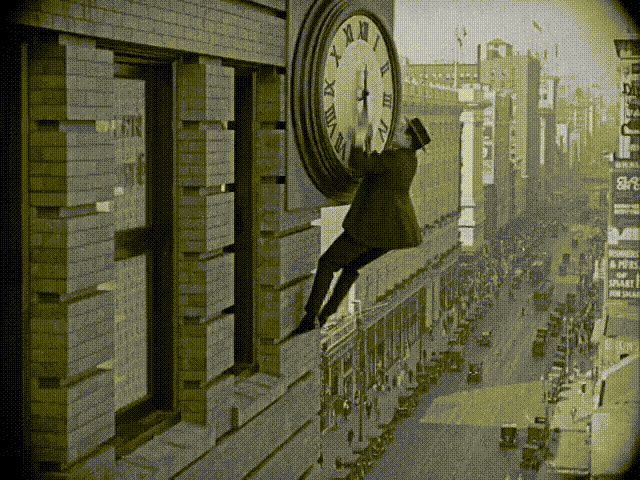When you can’t rely on a computer to improve (or fake) a movie scene, you gotta improvise. And back in the days of silent films, filmmakers were really, really good at coming up with creative ways to cook up special effects. It was a master class of using specific camera angles, splicing together shots, using glass matte paintings, and twisting perspectives to make things look as realistic as possible.
Silent Movie GIFs is an excellent resource that reveals how things used to be done in the past. He detailed a lot of famous examples in a wonderful post here. It’s a fun read for anyone.
1. Harold Lloyd hanging off a clock in Safety Last! (1923)
When Safety Last! was made, it wasn't feasible to insert a fake background using rear projection or a green screen, so they used a trick of perspective. The set was built at the right height for Lloyd's climb, but on the roof of a building across the street. As Lloyd climbed higher, the set was moved to taller buildings.
2. Charlie Chaplin roller-skating in a department store in Modern Times (1936)
A good example of the classic movie making technique of glass matte painting. Part of the background was painted on a piece of glass, which was placed in front of the camera.
3. Colleen Moore's eye trick in Ella Cinders (1926)
The two halves of her face were filmed separately, using a matte shot. Basically, a piece of glass with half the frame painted black was placed in front of the camera, so only one side the film was exposed. The film was then wound back, the glass was switched for one with black on the other side. The key was to avoid having either the camera or the Moore's face shift in position while shooting, or the effect would be ruined.
4. Mary Pickford kisses herself on the cheek in Little Lord Fauntleroy (1921)
Seeing two Mary Pickfords in the same shot wasn't anything new for audiences, it was also done in Stella Maris three years prior. Decades earlier, Georges Méliès had figured out how to appear multiple times in one shot by using mattes and double exposure. But in a normal double exposure, the actor can't move from one part of the frame to another without ruining the effect.
Famed cinematographer Charles Rosher achieved the effect of having Pickford move behind her own face by having a very detailed silhouette of Pickford painted on glass, and using a metal frame that prevented the camera from moving. The three-second shot took 15 hours of work to get right.
5. Douglas Fairbanks slides down a sail in The Black Pirate (1926)
The method for achieving this much copied shot was figured out by Fairbanks's brother Robert, an engineer. The camera and the sail were both placed at an angle. Fairbanks's knife was connected to a hidden pulley and counterweight. Airplane propellers were used to make the sails billow.
6. Buster Keaton rides over a broken bridge in Sherlock Jr. (1924)
Another matte shot. The bottom of the frame was blacked out, lining up with the top of the bridge, and Keaton was filmed riding while the bridge was still intact. The footage of the trucks was filmed separately with part of the bridge removed. Getting the timing right must have been tough.
The part at the end isn't a camera trick, Keaton actually did that.
7. Jesus heals some lepers in Ben-Hur (1925)
Karl Struss, another famous cinematographer, developed a technique using a colour filter to achieve this effect. When the filter was adjusted, the women's leper makeup was no longer visible on film. Struss used the same technique, in reverse, for the famous transformation scene in Dr. Jekyll and Mr. Hyde (1931).
(via Sploid/Gizmodo)
Silent Movie GIFs is an excellent resource that reveals how things used to be done in the past. He detailed a lot of famous examples in a wonderful post here. It’s a fun read for anyone.
1. Harold Lloyd hanging off a clock in Safety Last! (1923)
When Safety Last! was made, it wasn't feasible to insert a fake background using rear projection or a green screen, so they used a trick of perspective. The set was built at the right height for Lloyd's climb, but on the roof of a building across the street. As Lloyd climbed higher, the set was moved to taller buildings.
2. Charlie Chaplin roller-skating in a department store in Modern Times (1936)
A good example of the classic movie making technique of glass matte painting. Part of the background was painted on a piece of glass, which was placed in front of the camera.
3. Colleen Moore's eye trick in Ella Cinders (1926)
The two halves of her face were filmed separately, using a matte shot. Basically, a piece of glass with half the frame painted black was placed in front of the camera, so only one side the film was exposed. The film was then wound back, the glass was switched for one with black on the other side. The key was to avoid having either the camera or the Moore's face shift in position while shooting, or the effect would be ruined.
4. Mary Pickford kisses herself on the cheek in Little Lord Fauntleroy (1921)
Seeing two Mary Pickfords in the same shot wasn't anything new for audiences, it was also done in Stella Maris three years prior. Decades earlier, Georges Méliès had figured out how to appear multiple times in one shot by using mattes and double exposure. But in a normal double exposure, the actor can't move from one part of the frame to another without ruining the effect.
Famed cinematographer Charles Rosher achieved the effect of having Pickford move behind her own face by having a very detailed silhouette of Pickford painted on glass, and using a metal frame that prevented the camera from moving. The three-second shot took 15 hours of work to get right.
5. Douglas Fairbanks slides down a sail in The Black Pirate (1926)
The method for achieving this much copied shot was figured out by Fairbanks's brother Robert, an engineer. The camera and the sail were both placed at an angle. Fairbanks's knife was connected to a hidden pulley and counterweight. Airplane propellers were used to make the sails billow.
6. Buster Keaton rides over a broken bridge in Sherlock Jr. (1924)
Another matte shot. The bottom of the frame was blacked out, lining up with the top of the bridge, and Keaton was filmed riding while the bridge was still intact. The footage of the trucks was filmed separately with part of the bridge removed. Getting the timing right must have been tough.
The part at the end isn't a camera trick, Keaton actually did that.
7. Jesus heals some lepers in Ben-Hur (1925)
Karl Struss, another famous cinematographer, developed a technique using a colour filter to achieve this effect. When the filter was adjusted, the women's leper makeup was no longer visible on film. Struss used the same technique, in reverse, for the famous transformation scene in Dr. Jekyll and Mr. Hyde (1931).
(via Sploid/Gizmodo)




















.jpg)







0 comments:
Post a Comment